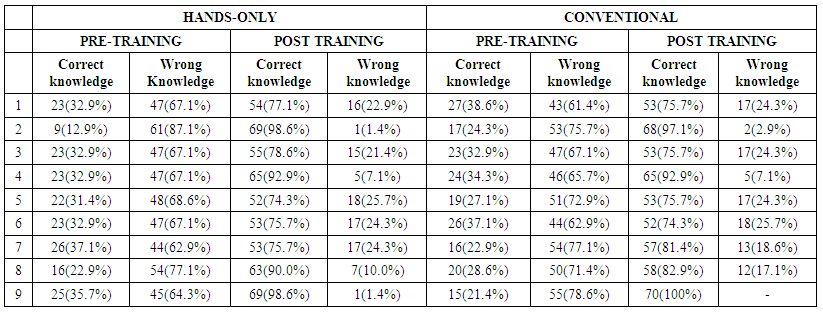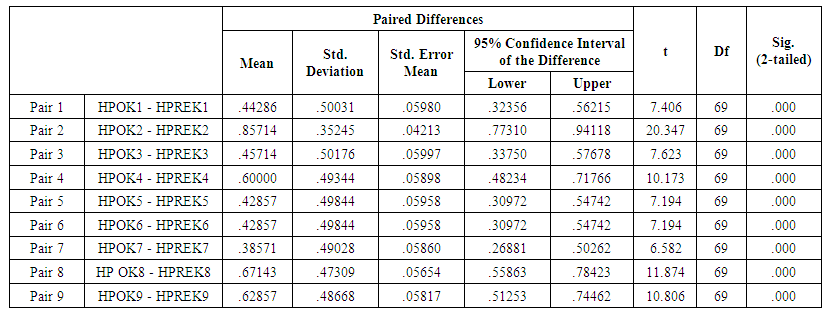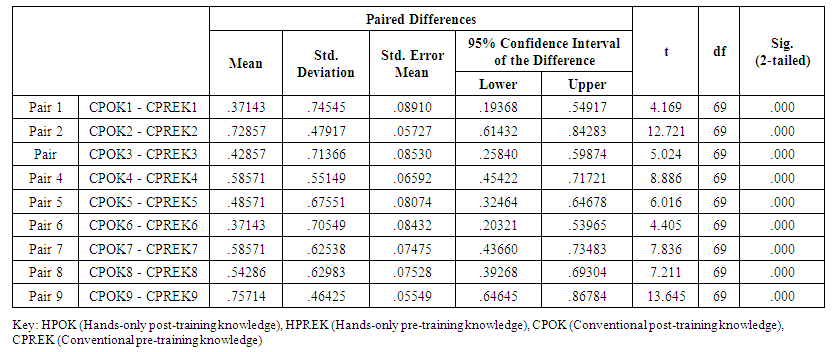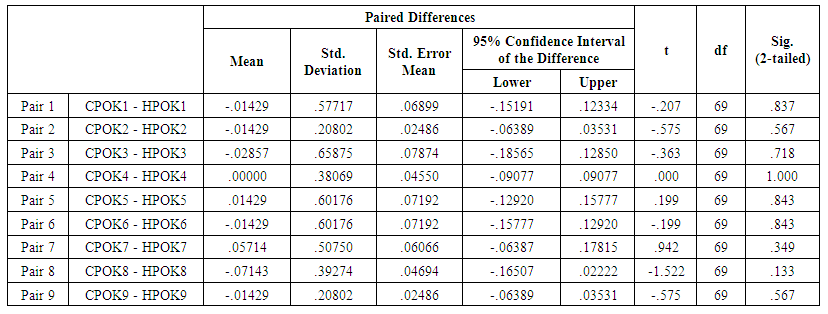-
Paper Information
- Paper Submission
-
Journal Information
- About This Journal
- Editorial Board
- Current Issue
- Archive
- Author Guidelines
- Contact Us
Journal of Health Science
p-ISSN: 2166-5966 e-ISSN: 2166-5990
2019; 9(1): 6-11
doi:10.5923/j.health.20190901.02

Cardiopulmonary Resuscitation Knowledge in a Nigerian University Students after a Conventional and Hands-Only CPR Training Programmes
Adedamola Olutoyin Onyeaso1, Chukwudi Ochi Onyeaso2
1Department of Human Kinetics and Health Education, Faculty of Education, University of Port Harcourt, Port Harcourt, Nigeria
2Department of Child Dental Health, Faculty of Dentistry College of Health Sciences, University of Port Harcourt / University of Port Harcourt Teaching Hospital, Port Harcourt, Nigeria
Correspondence to: Adedamola Olutoyin Onyeaso, Department of Human Kinetics and Health Education, Faculty of Education, University of Port Harcourt, Port Harcourt, Nigeria.
| Email: |  |
Copyright © 2019 The Author(s). Published by Scientific & Academic Publishing.
This work is licensed under the Creative Commons Attribution International License (CC BY).
http://creativecommons.org/licenses/by/4.0/

Introduction: Lack of adequate knowledge has been a major reason for fear and unwillingness by many laypersons across the globe to provide bystander CPR while the training technique could be an important factor in knowledge acquisition. This study aimed at assessing the pre-training and post-training theoretical CPR knowledge of two cohorts of Nigerian University students. Materials and Methods: A quasi-experimental study design was used involving two cohorts of 70 participants each. During the pre-training stage, both the compression-only and the conventional CPR groups were asked to respond to the self-administered questionnaire containing nine (9) questions on theoretical CPR knowledge. After the respective CPR trainings, they were given the same questionnaire to respond to the same questions. The data was analysed using descriptive, student’s t-test statistics, as well as the analysis of variance (ANOVA) with the statistical significance set as P < 0.05. Results: Both the hands-only and conventional CPR groups had very statistically significant improvements in their post-training theoretical knowledge of bystander CPR (P < 0.001), while no statistically significant difference was found in the post-training theoretical knowledge of the participants in the two groups (P > 0.05). Conclusion: Both CPR training methods were found very effective in imparting bystander CPR knowledge to the participants while none proved superior to the other. Recommendation: More related studies are needed in other parts of Nigeria.
Keywords: Gender, Association, Hands-only and Conventional bystander CPR, Nigeria
Cite this paper: Adedamola Olutoyin Onyeaso, Chukwudi Ochi Onyeaso, Cardiopulmonary Resuscitation Knowledge in a Nigerian University Students after a Conventional and Hands-Only CPR Training Programmes, Journal of Health Science, Vol. 9 No. 1, 2019, pp. 6-11. doi: 10.5923/j.health.20190901.02.
Article Outline
1. Introduction
- Considering the growing global public health burden of sudden cardiac arrest in today’s world especially in out-of-hospital cases, and the need for immediate initiation of high-quality cardiopulmonary resuscitation (CPR) which has been reported to significantly increase survival rate of such victims, there is need to train young people in the art and science of bystander CPR for the overall and long-term benefits of our communities [1-5].The death rate from out-of-hospital cardiac arrests (OHCA) in America, Europe, Asian and Middle East are not in any way encouraging and many of these deaths are not unconnected with poor bystander CPR provision for the victims [6-9].However, central to effective bystander CPR provision for victims of OHCA is the ability of bystanders, who are often medically untrained, to provide the needed services in such emergency situations. Meanwhile, laypersons cannot provide this important emergency service when they have poor. knowledge of what is expected of them. It is also known that OHCAs is not limited to developed nations but equally occur in many developing economies [10-12]. Therefore, both developed and developing nations are expected to be ready for this important public health concern. Unlike many countries of the world, Nigeria is presently ill-prepared for this.Although there are few related recent reports from Nigeria on knowledge of bystander cardiopulmonary resuscitation [13-19], there is still need for more data on this subject in our advocacy effort for the incorporation of bystander CPR teaching and training into the Nigerian schools’ curricula. The University students are a good target group for the success of this advocacy as potential future secondary school teachers and policy makers in our country.Therefore, this study aimed at assessing the pre-training and post-training theoretical knowledge of cardiopulmonary resuscitation (CPR) among a group of university students at the University of Port Harcourt, Port Harcourt, Nigeria.We hypothesized that: (1) there would be no statistically significant difference between the pre-training and post-training CPR knowledge of the students after the conventional CPR training; (2) there would be no statistically significant difference between the pre-training and post-training CPR knowledge of the students after the hands-only CPR training; and (3) there would be no statistically significant difference in the post-training theoretical knowledge of the two cohorts.
2. Materials and Methods
2.1. Research Design
- This study was carried out using a quasi-experimental cohorts design – one cohort was exposed to the conventional CPR training while the other cohort was taught hands-only CPR technique. However, both cohorts were taught together during the theoretical teaching before the different hands-on sessions.
2.2. Population of the Study
- The two groups (cohorts) were part of the larger 200-Level students of the Department of Human Kinetics and Health Education in the Faculty of Education of the University of Port Harcourt. The students were admitted into the Department in 2016. Although not all the thirty-six (36) States in Nigeria are represented in the sample, but due to the Admission Policy in all the Federal Universities in Nigeria which ensures that candidates from all the six (6) Geo-political Regions in the country are fairly admitted into every programme, the participants gave a very fair representation of the different States in Nigeria.
2.3. Stage 1 (Pre-training Phase)
- Before CPR teaching and trainings, one hundred and forty (140) copies of a self-administered questionnaire on their knowledge of cardiopulmonary resuscitation (CPR) was distributed to assess the pre-training CPR theoretical knowledge of the participants - seventy (70) in the hands-only cohort and another seventy (70) in the conventional CPR group. Nine questions on bystander CPR were captured in the questionnaire (Appendix).
2.4. Stage 2 (Immediate Post-training Phase)
- Immediately after the teaching and trainings on bystander CPR, another one hundred and forty (140) copies of the same questionnaire were given to the same participants to answer the same questions on CPR which they answered before the teaching and training sessions. All the participants in the two groups responded to the questions again.
2.5. Determination of Good and Poor CPR theoretical Knowledge
- For each of the nine (9) questions on CPR knowledge, a score of 50% was considered good while any score less than that was considered as poor CPR theoretical knowledge the following null hypotheses were generated and tested:Ho1: That there would be no statistically significant difference between the pre-training and post-training CPR knowledge of the students after the hands-only CPR trainingHo2: That there would be no statistically significant difference between the pre-training and post-training CPR knowledge of the students after the conventional CPR trainingHo3: That there would be no statistically significant differences in the post-training theoretical knowledge of the two cohorts.
2.6. Data Analysis
- The Statistical Package for Social Sciences (SPSS Version 20) was used to analyse the data. In addition to descriptive statistics, the data was analyzed using the paired samples T-test at P < 0.05 level of significance.
3. Results
 | Table 1. Frequency distribution of the pre-and post-training CPR knowledge of the participants in the two cohort groups |
 | Table 2. The Paired Samples T-test analysis of the difference between the post-training and the pre-training CPR knowledge of the participants in hands-only CPR group |
 | Table 3. The Paired Samples T-test analysis of the difference between the post-training and the pre-training CPR knowledge of the participants in conventional CPR group |
 | Table 4. The Paired Samples T-test analysis of the difference in post-training CPR knowledge in the hands- only CPR and the conventional CPR groups |
4. Discussion
- The present Nigerian study on the theoretical knowledge of cardiopulmonary resuscitation (CPR) after both hands-only and conventional CPR trainings have shown statistically significant improvement on the theoretical knowledge of bystander CPR by the participants in both groups. Meanwhile, no statistically significant difference in the post-training theoretical knowledge of the participants in the two groups was observed.The result of the present Nigerian study is comparable to those of few related earlier reports from Nigeria [13-16, 18]. These very significant improvements in CPR knowledge after CPR trainings should be seen as positive and encouraging finding for a developing economy like Nigeria. Lack of adequate CPR knowledge has been one of the major reasons for fear and unwillingness to attempt bystander CPR by laypersons in emergency situations and even poor outcomes of bystander CPR efforts generally, especially among low income environments [20]. According to Mpotos et al [20], 61% of the teachers interviewed felt incapable and unwilling to teach CPR because of their perceived lack of knowledge to do so despite their previous exposure to CPR teaching. Sasson et al [12] reported that patients who had an out-of-hospital cardiac arrest in low-income black neighbourhoods were less likely to receive bystander-initiated CPR than those in high-income white neighbourhoods.In that report by Sasson et al [12], they defined low-income and high-income neighbourhoods as those census tracts in which the median annual household income was less than $40,000 and $40,000 or more, respectively. Comparing the Nigerian environment where the present study and the earlier reports [13-16, 18] were carried out and the criteria for categorization of low-income and high-income neighbourhoods used by Sasson et al [12], it becomes very clear that the Nigerian environment can obviously be considered as a low-income one. In addition, schools are believed to be a good target area in the promotion of bystander CPR through teaching and training with the obvious effective secondary multiplier effects [20-24].It is interesting to note that there were no statistically significant differences in the post-training CPR knowledge of participants between the two cohorts. This means that their theoretical knowledge of CPR was not influenced by the type of CPR training technique used (whether the conventional or the hands-only CPR).It suggests that the hands-only CPR technique could be encouraged more in our environment without the participants losing out in knowledge considering the fact that some previous reports showed that among Nigerian participants in bystander CPR training and other parts of the globe were not comfortable with mouth-to-mouth CPR [14, 25-29].In fact, there is increasing evidence that compression-only (hands-only) CPR is very effective in out-of-hospital cardiac arrest (OHCA) victims [28, 30]. Bobrow et al [28], in their study concluded that among patients with out-of-hospital cardiac arrest, layperson compression-only CPR was associated with increased survival compared with conventional CPR and no bystander CPR in the setting with public endorsement of chest compression–only CPR.According to Tsegaye et al [29], with theoretical knowledge, a healthcare professional may be able to perform CPR sufficiently. They reported that among the medical students studied, lack of training, poor exposure time to CPR training and inadequate information were significantly associated with their inability to practice CPR. Of course, they lack confidence and willingness to practice CPR. They concluded that training was a significant factor which reinforces students to initiate CPR.Strengths and Limitations of this Study The two cohorts used in this study were drawn from a fairly representative of the Nigerian youths as they came from various States in the country but is limited by the fact that the study was based on simulated OHCA using manikins in their practical trainings outside the video and power-point teachings.
5. Conclusions
- This study has shown very statistically significant improvements in the theoretical post-training CPR knowledge of the participants in the both cohorts but no statistically significant difference in the post-trainings CPR theoretical knowledge of the participants in the two training techniques, meaning that no method of training produced superior impart of the theoretical knowledge but the two did significantly well.
6. Recommendations
- Ÿ Related studies should be carried out in other parts of Nigeria so as to increase the number of bystander CPR providers in the country.Ÿ There is need for regular training and re-training of these potential bystander CPR providers in Nigeria because their confidence and ability to perform this emergency procedure will depend on their CPR theoretical knowledge which will inform their practical performance.
 Abstract
Abstract Reference
Reference Full-Text PDF
Full-Text PDF Full-text HTML
Full-text HTML